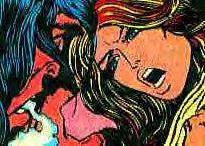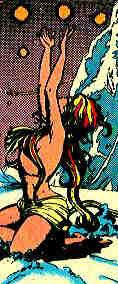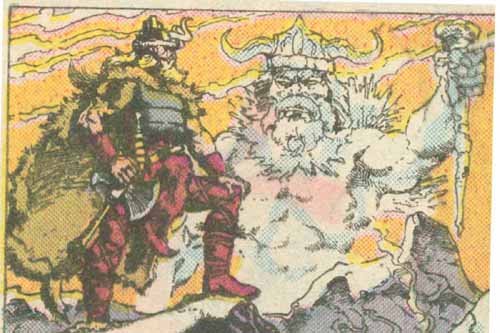
ATALI
Real Name:
Atali
Identity/Class: Goddess/Giantess, Hyborian Era
Occupation: Valkyrie/Harbinger of Ymir
Group Membership: Frost Giants/Ice Giant
Affiliations: Ymir
Enemies: Conan, (possibly) Borri, Borr, Odin, vampires of Vanaheim
Known Relatives: Ymir (father), Frost Giants/Ice Giants (brothers; two unnamed [deceased]), Loki, Utgard-Loki, Hela (share common ancestor)
Aliases: None
Base of Operations: Ymir's Valhalla
First Appearance: (historical) "Gods of the North",
Fantasy Fan (March 1934);
(Marvel) Savage Tales I#1 (May
1971)
Powers/Abilities: Atali presumably possesses the usual abilities of either a giantess or an Asgardian goddess, such as superhuman strength (class 25). She would not be immortal, but still very long-lived, and resistant to most Terran diseases.
History: (Official Handbook of the Conan Universe#1) - During Earth's Hyborian Age (after the sinking of Atlantis and before the Bronze Age, approximately 16,000 BC to 8,000 BC), the Frost Giant Ymir served as one of the most prominent gods of Earth, alongside Crom, Mitra, and others. Ymir was worshipped as a god by the people of Nordheim, a civilization composed of the human cultures of the Aesir of Aesgaard in the eastern portion and the Vanir of Vanaheim in the western portion. Ymir served as their lord of storm and war, and chief of all their deities. Ymir's domain was in Valhalla, a snowy, shadowy place that was home to soldiers slain in battle; apparently similar to the later relationship between the Mount Olympus of Greece and the otherdimensional Olympus of Zeus, Ymir's Valhalla was apparently connected to the mountains of northern Vanaheim, perhaps by some sort of portal or nexus. In any event, Ymir's daughter Atali appeared to dying combatants as the harbinger of their journey to Ymir's realm. Not surprisingly, for the Vanir, war was a sacred duty waged in the name of Ymir.
(Savage Sword of Conan#141 (fb) - BTS) - According to the old sagas of these Vanir people, a group of vampires once established a city in Vanaheim from which they lured animals and men to their deaths. The Vanir people managed to serve justice to these vampires, and Ymir himself buried the city of the undead beneath a mountain of frozen rock. These vampires would not be freed until ages later.
(Savage Tales I#1) - Conan took part in a brutal battle in the snows of Nordheim. Weary after slaying an enemy, and alone since the battle was over with all other combatants dead, he was surprised to find a winsome maiden flitting around the snow. This woman then ran off, taunting Conan. He followed her, only to be attacked by figures resembling two large men. The enraged Conan slew them both, and then advanced on the woman. The woman cried out to Ymir to save her just as Conan managed to rip off a piece of her strange gossamer dress, and then the woman disappeared.
Later, Conan woke up back on the battlefield.
He told his compatriots, who arrived from another skirmish, of what had happened.
They doubted that any woman ever ventured onto the battlefield, and suggested
that Conan, exhausted by the struggle, simply had had a dream of Atali, the
Frost Giant's daughter said to come to carry off those who died in battle
in Nordheim, and her brothers, the Frost Giants. However, then someone noticed
an odd thing in Conan's hand; a bizarre piece of gossamer
fabric...........
Comments: created/adapted by Robert E. Howard for the Hyborian Era; adapted by Roy Thomas and Barry Windsor-Smith.
The short story "The Frost-King's Daughter" or "The Frost-Giant's Daughter" has a complicated history. Robert E. Howard wrote it as a Conan story, but his editor rejected it. So, Howard changed the hero's name to Amra (actually a sly reference to an alias Conan used) and let a fanzine called Fantasy Fan publish it. Fantasy Fan retitled it "Gods of the North". After Howard died, Lyon Sprague de Champ found the original Conan manuscript of the story and rewrote it, and this version was published in The Coming of Conan (Gnome Press, 1953), Fantasy Fiction#1 (August 1953), and Fantastic Universe (December 1956), as well as the Lancer paperback Conan of Cimmeria (1969).
However, since then, both Howard's unedited first manuscript and the Fantasy Fan/Amra version of the story have appeared in Echoes of Valor II (Tor, 1991). The Conan Chronicles Volume 1 (Millennium) published in 2000 the Howard Conan manuscript version yet again.
Since Atali made his first published prose appearance in a fanzine, it is appropriate that her first comic book appearance was also in a fanzine. In the fanzine Star Studded Comics#14 (December 1968), someone wrote and drew an adaption of the Amra version of the story. This amateur version was reprinted recently in Fandom's Finest Comics, a collection of amateur comics stories.
Ymir in the Hyborian Era
Robert E. Howard did not extensively use the better known or still largely followed religions such as Hinduism ,Shintoism or Olympian polytheism for his stories, so the inclusion of the Conan stories in the Marvel Universe does not create too much overlap with other Marvel mythology adaptions. However, Howard's use of Ymir presents an exception, since Ymir had made several appearances in the Thor stories before the adaption of the Conan stories began, starting with Journey Into Mystery I#97/2.
However, there actually exists no problem in slotting Ymir's Hyborian Era presence in with the Ymir who appears in Thor. After all, the Ymir who faces Thor is supposed to be one of the oldest beings in the Asgardian cosmic hierarchy, so we can presume easily that he was around during the Hyborian Era. Probably Odin, Ville, and Ve slew Ymir at some point during the later part of the Hyborian Era, or after the Hyborian Era. They then usurped his worshippers, who, after the Hyborian Era ended, became the Vikings and other Germanic peoples. (I would chalk up the similarity in names of the human Aesir and Vanir to the godly Aesir and Vanir to common etymological roots.)
I have included a scan of
Ymir. It comes from the Vanaheim entry in The Official Handbook
of the Conan Universe#1. This image of Ymir does not resemble his usual biped
sheet of ice appearance per Ymir's chronologically earliest appearances or
his modern era appearances, but presents him as more humanoid, to the extent
of having facial hair. This could mean (1) this was what his human worshippers
thought Ymir looked like; they attributed to Ymir a more
human-like appearance but in fact he had a less humanoid form even during
then (it is not uncommon for a culture to depict its gods or prophets in
its own cultural image; this occurs with Jesus Christ, who gets frequently depicted with blue eyes and light brown hair
as in Renaissance Era Italian paintings. Most of the Christian
people who made those Renaissance Era paintings were middle to Northern
Europeans, so it did not occur to them that a historical Jesus Christ,
had he existed in the Middle East of the first century, would have resembled
a dark Semetic type similar to the Arabs).
It comes from the Vanaheim entry in The Official Handbook
of the Conan Universe#1. This image of Ymir does not resemble his usual biped
sheet of ice appearance per Ymir's chronologically earliest appearances or
his modern era appearances, but presents him as more humanoid, to the extent
of having facial hair. This could mean (1) this was what his human worshippers
thought Ymir looked like; they attributed to Ymir a more
human-like appearance but in fact he had a less humanoid form even during
then (it is not uncommon for a culture to depict its gods or prophets in
its own cultural image; this occurs with Jesus Christ, who gets frequently depicted with blue eyes and light brown hair
as in Renaissance Era Italian paintings. Most of the Christian
people who made those Renaissance Era paintings were middle to Northern
Europeans, so it did not occur to them that a historical Jesus Christ,
had he existed in the Middle East of the first century, would have resembled
a dark Semetic type similar to the Arabs).
(2) Ymir grew into a more humanoid appearance during the Hyborian Era due
to the faith of his worshippers, but after Odin slew him, and Ymir had to
regenerate himself, Ymir reverted to his old appearance. Ymir would have
then chosen not to expend the energy needed to reassume his more humanoid
form. (As the
Doctor and
Kulan Gath can attest, regeneration is a tricky business.)
Ymir's Valhalla was probably usurped by Odin, or Odin named his Valhalla after it. It remains possible that it was in Niffleheim, or else Ymir's progeny moved to Niffleheim after Odin had seriously decimated their ranks.
The vampires of Vanaheim returned thousands of years later, when they were defeated by the warrior priest Vitellus, who served the aforementioned god Mitra; Conan, and a Vanir woman named Kreenara. All three brandished the Mitran cross in one of the earliest recorded uses of the cross against a vampire; see Mitra entry for scans. There is no evidence that Atali was involved with their destruction, but we do not have a lot of other info on what Ymir did during the Hyborian Era, so I thought I would mention it.
Many of the images on this page came from this site.
The Hyborian Era Aesir and Vanir were human cultures who were the ancestors of the Germanic peoples. Their names probably have a common etymological root with those of the Aesir and Vanir who are gods. Similarly, the Hyborian country Aesgaard probably has a common etymological root with the dimension of Asgard.
If she was still among the living, Atali supposedly died during the Ragnarok in Thor II#85.
by Per Degaton
CLARIFICATIONS:
Atali, Ymir's daughter, should not be confused
with: images: (without ads) Other appearances:
Last updated:
06/28/05
Any Additions/Corrections? please
let
me know.
Non-Marvel
Copyright info
Savage Sword of Conan#141 (October, 1987) - Charles Dixon (writer), Gary Kwapisz (pencils), Ernie Chan (inks), Michael Higgins (editor)
All other characters mentioned or pictured are ™ and © 1941-2099
Marvel Characters, Inc. All Rights Reserved. If you like this stuff, you
should check out the real thing!
Please visit The Marvel Official Site at:
http://www.marvel.com